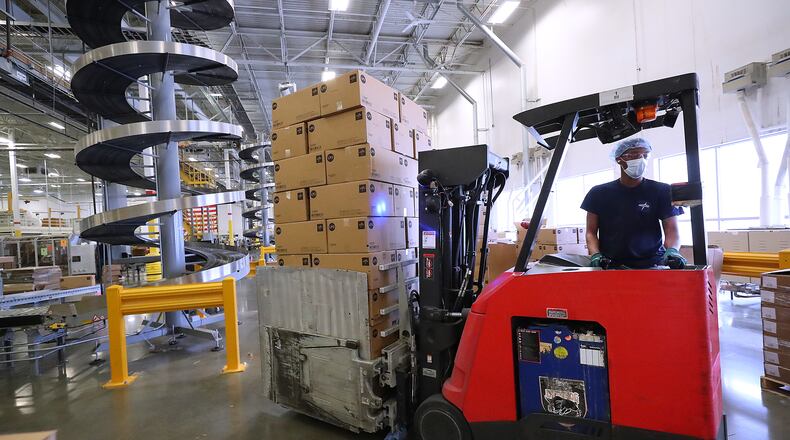For more than a year, metro Atlanta has steadily added back jobs as the region rebounds from a pandemic-induced double-digit unemployment rate. But August was a reminder that the economic recovery has been anything but even.
While most sectors showed job growth last month, some did not.
The metro area added just 2,300 jobs, compared to an average of 18,800 in a pre-pandemic August. With COVID-19′s continuing drag on business and consumer spending, the Georgia economy is still 74,800 positions shy of its February 2020 level.
The largest job loss came in accommodation and food services, which dropped 4,800 jobs during the month, the state Department of Labor said Thursday. Hotels aren’t getting the convention business they usually do, and restaurants that depend on tourists and conventioneers are especially hurt, experts say.
Local hotel revenue from business travelers is forecast to be down 71% this year compared with pre-pandemic levels, according to the American Hotel & Lodging Association. The Atlanta Convention & Visitors Bureau doesn’t expect a return to 2019 levels until late 2023.
Still, some industries are looking for workers, including many restaurants.
The unemployment rate fell to 3.1% last month from 3.2% the month before, though that calculation partly masks the true labor picture since it does not include people who are no longer looking for jobs. The labor force has shrunk by 22,332 from July to August.
Because of the labor shortage, even restaurants that are doing good business are shifting hours, changing menus and adding devices to substitute for workers, said Sean Palani, an Atlanta-based restaurant hospitality consultant. “There are so many restaurants that are short-staffed,” Palani said.
Willie Degel, owner of three Uncle Jack’s restaurants in the metro area, said he has struggled to fill the roughly 75 positions at each, though he’s spending a lot of money on ads.
“Do we need more people? Yes. Do we turn over a lot of people? Yes,” he said.
The labor shortage, attributed to the pandemic, “will continue to cause a hiring crunch until we can attract more people back to the workforce to fill the record number of job openings,” said state Labor Commissioner Mark Butler.
Many businesses have raised wages and added incentives to fill positions. The approach of the holiday shopping season only adds to the demand.
Medline Industries has added 82 workers in the past three months and expects to hire several hundred more at its 1.1 million-square-foot Lithia Springs factory and warehouse complex, according to Harold Brand, director of human resources.
“The hardest to fill are the warehouse jobs,” he said. “Frontline positions are highly competitive right now. People have choices.”
The $17.5 billion, Illinois-based company raised pay to between $16 and $19 an hour for those workers, Brand said. “We are confident that we are competitive with the market now, but those jobs are the hardest to staff.”
The site currently has about 500 workers.
Evans Tool & Die in Conyers has been hiring, too, mainly engineers and press operators, said Deanne Barnes, chief executive of the 72-year-old, family-owned company.
The 65-worker factory, which stamps metal parts used in a range of mechanisms from medical devices to golf carts, has seen a surge in orders during the pandemic as U.S. companies look for sources closer to home.
“Business is robust right now,” she said. “We had to raise our wages just to be competitive.”
The logistics sector has boomed right through the pandemic, fueled by online orders for goods. Big names like Amazon have hired thousands of workers and added massive new warehouse and distribution centers.
Alabama Motor Express is opening a new terminal in Jackson, south of Atlanta, and is trying to fill more than 50 positions, including drivers and logistics jobs, said spokeswoman Erin Swensen.
“It has its challenges,” she said. “The company has some employees that have been there for 30 years. So the challenge is, we are good at retaining people, but how do we get new ones?”
Drivers — depending on routes and seniority — now make between $1,000 and $1,600 a week, she said.
August job growth, metro Atlanta
2021: 2,300
Pre-pandemic average: 18,800
May-August, 2021: 59,800
May-August, pre-pandemic average: 16,400
________________________
Metro Atlanta, unemployment rate
Those in labor force but jobless
August, 2021: 3.1%
Feb., 2020: 3.3%
________________________
Metro Atlanta, labor force
August, 2021: 3,105,015
Feb., 2020: 3,156,234
________________________
Metro Atlanta, change in labor force
Jan.: -30,535
Feb.: 32,077
Mar: 12,318
Apr: 10,229
May: -13,680
June: 25,639
July: -237
August: -22,332
Sources: Georgia Department of Labor, Bureau of Labor Statistics
________________________
About the Author
Keep Reading
The Latest
Featured



